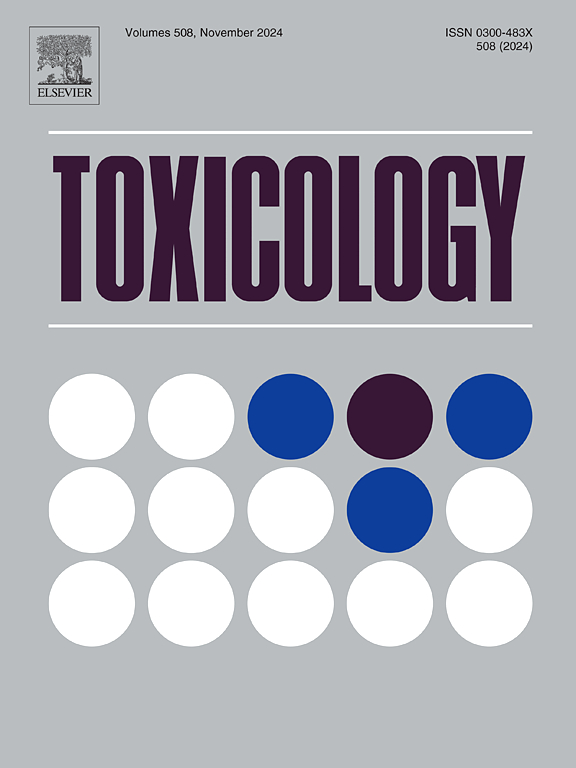DNA加合物形成导致肾衰竭的不良结果途径
IF 4.8
3区 医学
Q1 PHARMACOLOGY & PHARMACY
引用次数: 0
摘要
不良后果途径(AOP)是毒理学和风险评估中的一个概念框架,概述了从化学物质的分子相互作用到由此产生的不良健康影响的一系列事件。这个框架提供了一种结构化的方法来组织生物学知识,使其对理解化学物质造成伤害的机制特别有用。在对文献进行全面分析后,AOP阐明了由铂抗癌药物等化合物引起的DNA加合物形成与肾小管坏死(导致肾衰竭)相关的关键事件。目前,顺铂、卡铂和奥沙利铂是全球用于治疗癌症的三种最常用的基于pt的药物。细胞摄取后铂抗癌剂的水解产生亲电中间体,其共价结合到DNA上的亲核位点形成加合物,代表分子起始事件。当DNA修复机制变得不平衡时,DNA加合物形成后的肾毒性反应会导致DNA损伤和线粒体功能障碍。这些事件促进活性氧(ROS)的产生和释放,诱导氧化应激,导致细胞死亡和炎症。一旦脱离基底膜,这些受损的细胞随后沉积在管状管腔中。小管梗阻和近端小管损伤引起的炎症反应可导致继发性毒性和小管坏死,进一步加重肾损伤,促使肾功能进行性下降,最终导致肾衰竭。本文章由计算机程序翻译,如有差异,请以英文原文为准。
An adverse outcome pathway for DNA adduct formation leading to kidney failure
An Adverse Outcome Pathway (AOP) is a conceptual framework in toxicology and risk assessment that outlines the series of events from a chemical's molecular interaction to the resulting adverse health effect. This framework offers a structured approach to organizing biological knowledge, making it especially useful for understanding the mechanisms through which chemicals cause harm. Following a comprehensive analysis of the literature, an AOP was elucidated for key events linking DNA adduct formation, caused by compounds such as platinum anticancer drugs, to tubular necrosis, resulting in kidney failure. Currently, cisplatin, carboplatin and oxaliplatin are the three most utilised Pt-based drugs used globally for the treatment of cancer. The hydrolysis of platinum anticancer agents post-cellular uptake yields electrophilic intermediates that covalently bind to nucleophilic sites on DNA to form adducts that represent the molecular initiating event. When DNA repair mechanisms become unbalanced, the nephrotoxic response following the formation of DNA adducts leads to DNA damage and mitochondrial dysfunction. These events promote the generation and release of reaction oxygen species (ROS) to induce oxidative stress, causing cell death and inflammation. Upon detachment from the basement membrane, these compromised cells are subsequently deposited in the tubular lumen. Tubular obstruction and inflammatory responses to proximal tubule insult can lead to secondary toxicity and tubular necrosis, further exacerbating kidney injury and precipitating a progressive decline of renal function, finally resulting in kidney failure.
求助全文
通过发布文献求助,成功后即可免费获取论文全文。
去求助
来源期刊

Toxicology
医学-毒理学
CiteScore
7.80
自引率
4.40%
发文量
222
审稿时长
23 days
期刊介绍:
Toxicology is an international, peer-reviewed journal that publishes only the highest quality original scientific research and critical reviews describing hypothesis-based investigations into mechanisms of toxicity associated with exposures to xenobiotic chemicals, particularly as it relates to human health. In this respect "mechanisms" is defined on both the macro (e.g. physiological, biological, kinetic, species, sex, etc.) and molecular (genomic, transcriptomic, metabolic, etc.) scale. Emphasis is placed on findings that identify novel hazards and that can be extrapolated to exposures and mechanisms that are relevant to estimating human risk. Toxicology also publishes brief communications, personal commentaries and opinion articles, as well as concise expert reviews on contemporary topics. All research and review articles published in Toxicology are subject to rigorous peer review. Authors are asked to contact the Editor-in-Chief prior to submitting review articles or commentaries for consideration for publication in Toxicology.
 求助内容:
求助内容: 应助结果提醒方式:
应助结果提醒方式:


